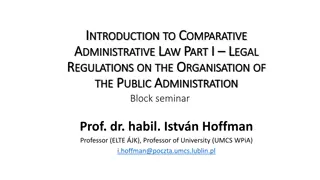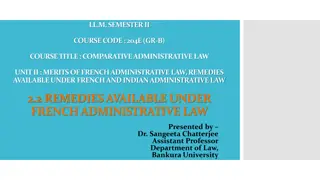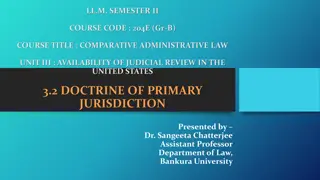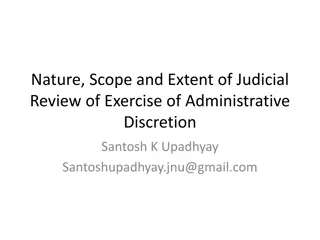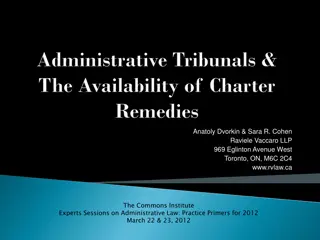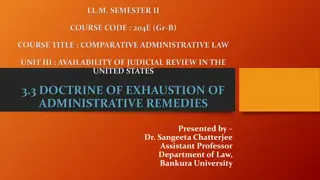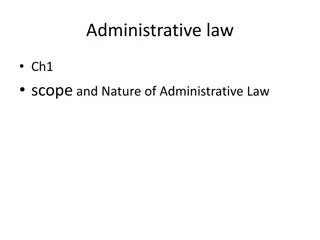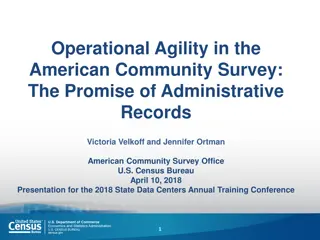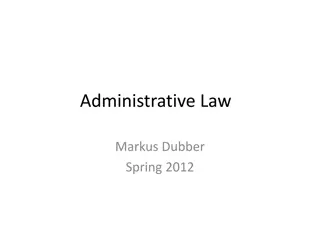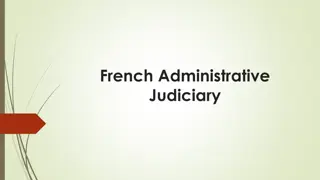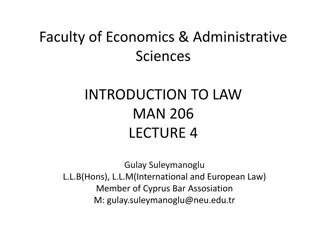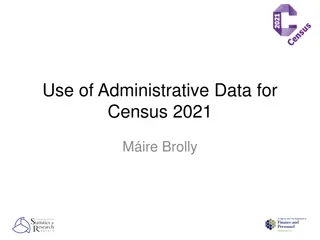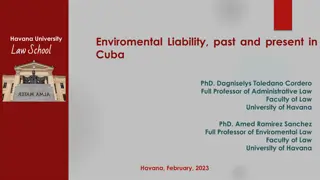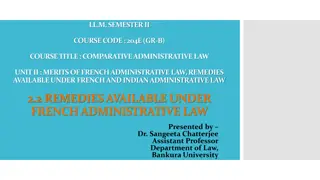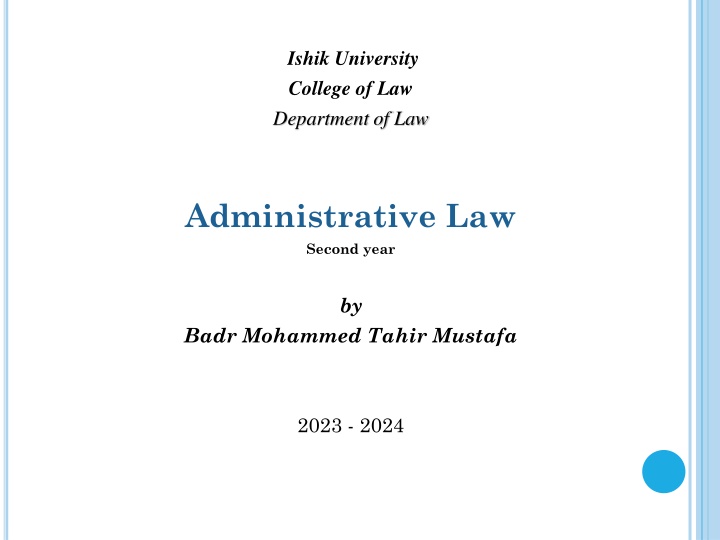
Administrative Law: Definition, Development, and Characteristics
Explore the concept of administrative law, its definition, historical development, and key characteristics. Discover how this branch of law regulates administrative bodies to achieve the public interest while maintaining a balance between private rights and governmental powers. Learn about the evolution of administrative law from the French Revolution to modern times.
Download Presentation

Please find below an Image/Link to download the presentation.
The content on the website is provided AS IS for your information and personal use only. It may not be sold, licensed, or shared on other websites without obtaining consent from the author. If you encounter any issues during the download, it is possible that the publisher has removed the file from their server.
You are allowed to download the files provided on this website for personal or commercial use, subject to the condition that they are used lawfully. All files are the property of their respective owners.
The content on the website is provided AS IS for your information and personal use only. It may not be sold, licensed, or shared on other websites without obtaining consent from the author.
E N D
Presentation Transcript
Ishik University College of Law Department of Law Administrative Law Second year by Badr Mohammed Tahir Mustafa 2023 - 2024 1
THECONCEPTOFADMINISTRATIVELAW Administrative law expanded greatly during the 20th century as legislative bodies worldwide created more governmental agencies to regulate the social, economic and political spheres. Administrative Law is a part of the legal framework for public administration. Public administration is the day-to-day implementation of government policy and it aims at preparing civil servant for 2 working in the public service.
Definition of Administrative Law Administrative Law is the branch of law that regulates the administrative bodies in the state and governs the activities carried out by the administrative agencies to achieve the public interest. This law controls Administrative power. One of its primary purposes is to keep the powers of Administrative bodies within their legal bounds in order to protect the citizens against their abuse. 3
HISTORICALDEVELOPMENTOF ADMINISTRATIVE LAW: Administrative law is regarded as recent law if it is compared with other ancient laws such as criminal law and civil law because its roots can be traced back to 1789. (French revolution). Before that time France and other European countries were governed by absolute monarchs so those monarchs and their dictatorial monarchy systems have not submitted to any law especially the administrative law which contains specific legal principles and rules which limit the power of governors. 4
Before the France Revolution, the Judicial Parliaments obstructed administrative reforms. In 1790, the revolutionists abolished them and prevented the judicial from intervening in administrative matters according to principle (separation between the powers). These developments have made the administration responsible for its conflicts. It had the power to issue judgment about its cases; it was known as the judicial administration. After Napoleon Bonaparte became the Emperor of France and during his period, French State Council was established. Gradually, this council has become responsible for all administrative conflicts. 5
Characteristics of Administrative Law It is flexible law. It establishes the balance between private rights and public interests. It is judge- made law Characteristic s of Administrativ e Law
1. ITIS JUDGE MADE LAW Administrative law is essentially Judge-made law or (case law) ,No doubt there are some written laws and regulations in administrative law. But, they are not its most important components, usually; they govern a very specific matter. On the other hand, the fundamental principles of administrative law are not enacted. These principles are derived from the decisions rendered by the administrative courts.
2. ITISA FLEXIBLE LAW As the rules of administrative law are not written, so they have a kind flexibility, which permits constant adaption to changes in administrative life. This flexibility makes it possible to dispense with enacted law. concerning the liability of the state have evolved in France from position on non- liability to one far more binding than for individual citizens. Thus the rules
Concerns of Administrative Law Administrative Law is concerned with the following topics: It studies powers of administrative agencies. It also studies applicable rules and principles while exercising administrative powers such as principles of fairness, reasonableness, rationality and the rules of natural justice. 9
Administrative law studies controlling mechanisms such as legislative and institutional control and the control of courts through judicial review. It is concerned with remedies available to aggrieved parties whose rights and interests may be affected by unlawful and unjust administrative actions. 10
Talk about Purpose of Administrative Law? 1. controlling the manner of exercising public power so as to ensure that rule of law is applied. 2. respecting the rights and liberties of individuals. 3. enhancing accountability and transparency. 4. embodying positive principles to facilitate good administrative practice. In order for the above-mentioned purposes to be achieved, it is necessary to have a governing system rooted in basic principles of rule of law and good administration. 11
SOURCESOF ADMINISTRATIVE LAW Sources of Administrative law can be divided into two categories: The main sources: The secondary sources: A- The main sources: 1. The Constitution: The Constitution is the creator of several administrative bodies and agencies. It briefly sets forth details about mechanisms, procedures and administrative powers granted to various authorities. It contains provisions regulating the manner of government administration, administration regulation and accountability of public bodies. 12
Constitutional law is the branch of the public law of a state which contains: A. The organization, powers, and frame of authorities. B. The distribution of political and governmental authorities. C. The fundamental principles which regulate the relations of government and citizens. D. The fundamental principles which prescribes generally the plan and method of public affairs which must be administered. Article 122 in the Constitution of republic of Iraq in 2005. 13
2. Legislation Laws adopted by parliament, can be considered one of the primary sources of administrative law. The statute creating an agency known as enabling act or parent act, clearly determines the limit of power conferred on the created agency. An administrative action exceeding such limit is an ultra vires, and in most countries the courts will be ready to intervene and invalidate such action. Usually, administrative law provisions are not codified in one legal code due to the continuously developing government activities. However, it can be found in various pieces of legislations.The Law of 14 Governorates No. 3 of 2009 is an example of administrative legislation in the Kurdistan region. Give an example of Administrative Law?
3. Judgments Judgments are the most important source of administrative law and the main historical source of its theories and principles such as the emergency circumstance theory and the administrative responsibility theory. However, when the judge issues an administrative judgment, he/she is not considered as a legislator since the judge practices his/her own task; thus, when there are no applicable obvious written or customary rules, the judge tries to find out a suitable solution as a result, his/her rule deemed as a new administrative law source. The judgment of (Tribunal of Conflicts) about Blanco case in 1873 in France, this judgment created a theory after thirty years from that time. 15
4. Custom Administrative customs represent a consecutive conduct which is followed by public administration during its activities. A custom should be general and practiced by the administration. The custom should not, however, contain any contrary conduct with legal rules. These elements create an obligatory custom. Hence, any such contradicting conduct will be refused and may result in legal punishment. 16
Secondary Sources of AL 1. Delegated Legislation Is a legal instrument issued by executive authority whereby the legislator authorizes a minister to adopt regulations containing technical and other details intended to facilitate the implementation of the statute in question. In another words, the legislative authority delegates the executive authority to take necessary actions. Delegated legislations are used to save parliament time. Article 30 of the Federal Investment Law No 13 of 2006 states that: the Council of Ministers shall adopt regulation in order to facilitate the implementation of this law. 17
2. Jurisprudence Is the views of competent scholars in law including their explanations and interpretations, whether in their books, or research, or lectures. The role of jurist is limited to explain provisions of the law, and to interpret its ambiguity. Therefore, jurisprudence helps lawmaker who amends the law and judges who apply it. 18
The Relationship between Administrative Law and other Laws and Concepts Constitutional Law and Administrative Law Similarities 1- Both are categorized under public law. 2- Both are concerned with functions of government. Differences While constitutional law deals, in general, with the power and structures of government, i.e. the legislative, the executive and the judiciary, administrative law in its scope of study is limited to the exercise of power by the executive branch of government . 1. Constitutional administrative law. Administrative law does not provide rights. Its purpose is providing principles, rules and procedures and remedies to protect fundamental rights set forth by constitutional law. law supersedes all other laws including 2. 19
ADMINISTRATIVE LAWAND HUMAN RIGHTS LAW The particular task of administrative law in the era of human rights protection is to ensure that public powers are not exercised in a way that impinges upon the human rights. Therefore administrative law mechanisms have been used to enforce human rights. Administrative law and human rights law are principally concerned with ensuring that public power is fairly and transparently exercised. They also share underlying values such as autonomy, dignity and security. 20
There are also marked differences between the two areas of law. Human rights law is principally concerned with protecting and ensuring substantive rights and freedoms whereas administrative law focuses more on procedure and judicial review attempts made to preserve a strict distinction between the legality and the merits of a decision. 21
ADMINISTRATIVE LAWANDFINANCIAL LAW Financial law regulates financial activities in/of the state and determines its expenses and revenues with the balances between them. Its relation with administrative law appears when we realize that public agencies cannot function properly without money or fund to practice their activities. So, financial law regulates the financing of the public 22 bodies.
Administrative Regulation Centralisation: Centralization (Central Administration) is the process by which the activities of government, particularly those regarding decision-making process, become concentrated within a particular location and a particular group. According to this shape of administration, the central government alone practices the administrative function in the state. 23
There are two types of centralism: 1. Concentrated administration: this means that all authorities of the state are in the hand of the central government without any participation by the officials in the local governments. 2. Non-concentrated administration: under this system, the central government grants partial participations to the regional authorities under its rigid control and supervision. 24
ADVANTAGESOF CENTRALISM 1. It makes the legal and political unity of the state coherent. 2. It leads to uniformity of systems and plans across the country. 3. It reduces co-ordination problems that is, the central government has the authority to order all local governments to act in a specific manner. 25
DISADVANTAGES 1. Since all decisions are made at the highest level of authority, centralisation might result in delays in decision-making and communication. 2. It is not in line with democratic principles. 3. It does not give opportunity to lower bodies to develop their administrative skills. 26
Decentralization Is a system in which the powers and responsibilities are transferred from the central authority to the local authorities. It may contribute to key elements of good governance by increasing people's opportunity for participation in economic, social and political decisions; allowing local and regional governments to manage their own affairs; Enabling local governments to respond to people's needs and 27 priorities.
Therefore, decentralization is consistent with the principles of democracy because powers are shared, citizens can express themselves and participate in governance via their representatives. 28
ADVANTAGESOF DECENTRALIZATION 1. It reduces the workload of the central authorities. 2. It makes decision-making process quicker and more feasible. 3. Local bodies will have sufficient authority to formulate their own policies and procedures. 4. It encourages development of managerial personnel; thus, they can improve their skills. 29
DISADVANTAGESOF DECENTRALIZATION 1. It increases the administrative expenses. 2. It may leads to co-ordination problem among central and local administrations. 3. It leads to prejudice the unity of the state through distribution of administrative functions. 4. Conflict may arise between central and local authority because local authorities often give priority to local interests rather than 30 public interests.
ADMINISTRATIVEAGENCIES The Meaning of Administrative Agencies: It could be defined as government entities which have been empowered with the authority to direct and supervise the implementation of particular legislation. Agencies may have other names such as commissions, corporations, boards or departments. Although they affect the rights and duties of individuals, they are neither courts nor legislatures. 31
Administrative agency rules and regulations often have the force of law towards individuals. The power of these agencies is specified according to agency's responsibilities as set out in the enabling statute. Agencies are created with varying sizes, structures, functions and powers. Some of them may be established with broader powers; in charge of regulating a certain sector of the economy. 32
REASONSFORTHE CREATIONOF AGENCIES The following are the main reasons for the creation of administrative agencies: The existence of recognized problems in the society Addressing and tackling the issues which may arise in the course of executing a legislation or even afterwards Providing specificity, protection and services 33
PURPOSEOF ADMINISTRATIVE AGENCIES Administrative agencies are established by the legislator to perform specific tasks which have been assigned to them by law. The main purposes are: managing crises and redressing serious social problems overseeing complex matters of governmental concern beyond the expertise of legislators implementing public compulsions such as tax and conscription 34 providing goods and services
E-Government refers to the utilization of Information Technology (IT), computer network and usually the Internet for delivering government services and exchange of information to the members of the public and private sector. e.g. of services: payment of utility bills, reservations of train tickets, getting birth and death certificates, vehicle permits, driving licenses etc. These services are available at separate offices and normally time-consuming because of slow processing and often large crowds waiting for the services. Therefore, It will save time and the bother of running around various departments. 35
Benefits of E-government: 1. lessening corruption and bureaucracy in administration 2. improving the efficiency of the administrative system 3. increasing transparency 4. revenue growth, and cost reductions. 5. in addition, moving away from a heavily paper-based system to an electronic system this would reduce the need for man-power 36
THEADMINISTRATIVEACTIVITIES The administrative police: This term refers to a body of administrative decisions and procedures adopted by the government aiming to prevent and protect the public order from troubles. The elements of administrative police are: The public security The public health 37 The public quietude
LIMITSOFTHEADMINISTRATIVEPOLICE: 1- During Ordinary Circumstances During ordinary circumstances, all decisions and procedures made by the executive to enforce the administrative police must submit to the law because the limits of the public administration are narrow. Any contrary conduct of the public administration to the law will be refused according to the narrow concept of administrative power. 38 The supervision of the judicial institutions will be wide.
2- During Emergency Circumstances The emergency circumstances have either been caused by human conducts such as war, or by nature such as earthquakes or floods. These circumstances make the power of public administration wide according to the wide concept of administrative power. The supervision of the judicial institutions will be narrow. 39
THE ADMINISTRATIVE DECISION It refers to the expression of the will of administration unilaterally to create or amend or abolish a legal position. It is the most important instrument which makes the administration supreme because it makes the administration able to obligate citizens and punish anyone who violates rules of law. 40
ELEMENTSOF ADMINISTRATIVE DECISIONS 1 Specialization Administrative decisions should be issued by specialized administrations; this element is fulfilled when the administration has the following: The material (substantive) specialization The regional specialization The time of specialization 1. 2. 3. 41
2 The Form of Administrative Decisions Generally, the administrative decision, whether it is positive or negative, shall be written and has a reference number and a date of issuance. If the law requires a certain legal form, the administration must follow it when issuing its decision; if the official ignores this legally-required form, his decision will be refused. 42
3 The Reason of Administrative Decisions It is the material and legal cases that cause the administration to issue a decision. Good decisions are attached by reasons to justify them. In a good administration, the reasons behind decisions are visible and available to those whom the decision affects. Being able to articulate a reason promotes accountability and provides transparency, allowing for greater scrutiny and enhancing understanding and acceptance. 43
4 The Object of Administrative Decisions The object is the legal consequence which the decision produces. This consequence appears when the decisions create or amend or abolish a legal position. It shall, in anyway, be legal and not contrary with the law. 44
5 The Intention of Administrative Decision The administrative decision shall be an instrument to realize the public interest. This means that the capability of administration in issuing decisions isn t a decisive one because its power is restrict by the public interest. So, if an administrative decision realizes or aims to realize a personal interest, it would be refused and abolishable. 45


